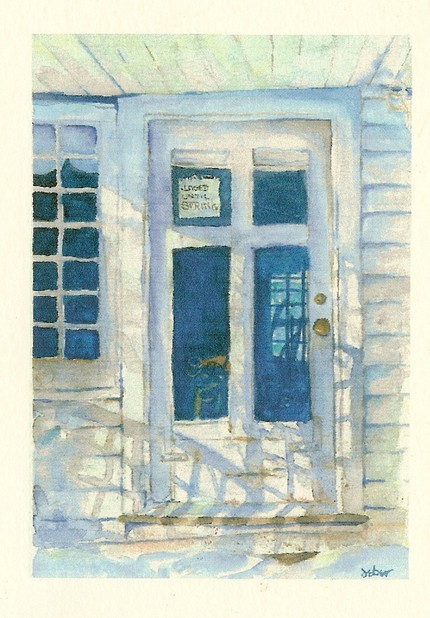I'll try anything once...if its not illegal, immoral or stupid.
One of the things that I keep trying and trying is the fascinating art of Bonsai. I have books on Bonsai; several of them. I am obsessed with the process of turning an ordinary potted plant (in this case, a Buxus Sempervirens - Dwarf English Boxwood) into a tree in miniature. Instead of writing a lot of words on the subject tonight, I'm going to illustrate it for you in photographs. I know you can get this stuff on other websites, by Bonsai pro's, and I'm not a pro. But it is sometimes encouraging to learn something from a friend, and not a professional. Professional perfectionism can be intimidating. You won't be intimidated by my Bonsai skills.
 The front of this Bonsai is pictured at left, and the back is pictured at right. I chose the one on the left to be called the front because I like the roots showing. Unfortunately, I have once again lost a couple of branches when potting this year, due to brittleness. I am hoping some new branches will start next spring. If so, I will find one worth keeping, and train it to grow to replace the lost branch. Around the base, I added local moss which I found around my apartment, and some micro-thyme, as a ground cover. It's healthy and doing well. We keep it well watered, and fertilize occasionally with fish emulsion, at half strength.
The front of this Bonsai is pictured at left, and the back is pictured at right. I chose the one on the left to be called the front because I like the roots showing. Unfortunately, I have once again lost a couple of branches when potting this year, due to brittleness. I am hoping some new branches will start next spring. If so, I will find one worth keeping, and train it to grow to replace the lost branch. Around the base, I added local moss which I found around my apartment, and some micro-thyme, as a ground cover. It's healthy and doing well. We keep it well watered, and fertilize occasionally with fish emulsion, at half strength.
Bonsai is not an art for the impatient soul...unless you buy one ready made by someone else who has the patience of Job. But Bonsai is well worth waiting for. I just like being able to say, I did this one, myself.
...So what if everyone else is thinking..."Yes...I believe you..." :)
One of the things that I keep trying and trying is the fascinating art of Bonsai. I have books on Bonsai; several of them. I am obsessed with the process of turning an ordinary potted plant (in this case, a Buxus Sempervirens - Dwarf English Boxwood) into a tree in miniature. Instead of writing a lot of words on the subject tonight, I'm going to illustrate it for you in photographs. I know you can get this stuff on other websites, by Bonsai pro's, and I'm not a pro. But it is sometimes encouraging to learn something from a friend, and not a professional. Professional perfectionism can be intimidating. You won't be intimidated by my Bonsai skills.
| I told my husband today that I had a hankerin' for makin' a Bonsai,
a miniature tree. Again.
I get on a Bonsai Binge about once every year or two.
Though I have made them before, but the real trick is as much in
maintaining them through a hot summer as it is making them.
So although I've done this again and again, I must keep trying.
We went to Home Depot and found this potted, untamed beauty for $4.45.
A bargain indeed! With a thick trunk, it should make a great Bonsai.
(And if you want to make it into a Bonsai,
and you aren't a professional, it better be a bargain.)
|
After you've decided what you are shooting for,
(I wanted a tree with an interesting trunk...something...interesting.)
I hold down the branches and decide "does this look good? Does this look stupid")If it doesn't break while I'm holding it down, then I save it for wiring. |
 |
| When I was done with my creation, I cut the pot off the root ball. I didn't want to damage the work I'd done. |
You know, my Bonsai is at the "awkward teenager" stage. Actually, it turned out to look a lot like some of my artwork, like "Old Queen Elizabeth", above. I am not finished with this bonsai, yet. I have potted it in a larger pot than I want, and I'm going to give it a rest and save trimming the roots for another time, after I've had time to think about the type of pot I want to use. For now, I'm ready to tackle the Azalea I just bought. This one should be interesting, too.
You might want to try your own hand at making a bonsai. You can do it. My advice is start with an inexpensive plant, go easy on it, and just have fun. Don't expect perfection...nature isn't perfect, either.
Update - One Year Later:
I thought you'd want to see the above Bonsai after one year. I have done more trimming as I saw fit, and have kept new growth to a minimum. It is slowly becoming more of the vision I had in mind when it was begun.
Just as I said I should, I did leave this tree for planting into a Bonsai pot until March. At that time, I removed it from the blue pot. I trimmed the roots as much as I could, *leaving enough large roots to anchor the plant and enough of the small, fine roots which are for water gathering. I like the look of a tree growing on a little hill, which also accommodated all the roots, so I allowed it to mound above the pot, as much for effect as for the health of the tree.
Just as I said I should, I did leave this tree for planting into a Bonsai pot until March. At that time, I removed it from the blue pot. I trimmed the roots as much as I could, *leaving enough large roots to anchor the plant and enough of the small, fine roots which are for water gathering. I like the look of a tree growing on a little hill, which also accommodated all the roots, so I allowed it to mound above the pot, as much for effect as for the health of the tree.
 The front of this Bonsai is pictured at left, and the back is pictured at right. I chose the one on the left to be called the front because I like the roots showing. Unfortunately, I have once again lost a couple of branches when potting this year, due to brittleness. I am hoping some new branches will start next spring. If so, I will find one worth keeping, and train it to grow to replace the lost branch. Around the base, I added local moss which I found around my apartment, and some micro-thyme, as a ground cover. It's healthy and doing well. We keep it well watered, and fertilize occasionally with fish emulsion, at half strength.
The front of this Bonsai is pictured at left, and the back is pictured at right. I chose the one on the left to be called the front because I like the roots showing. Unfortunately, I have once again lost a couple of branches when potting this year, due to brittleness. I am hoping some new branches will start next spring. If so, I will find one worth keeping, and train it to grow to replace the lost branch. Around the base, I added local moss which I found around my apartment, and some micro-thyme, as a ground cover. It's healthy and doing well. We keep it well watered, and fertilize occasionally with fish emulsion, at half strength.Bonsai is not an art for the impatient soul...unless you buy one ready made by someone else who has the patience of Job. But Bonsai is well worth waiting for. I just like being able to say, I did this one, myself.
...So what if everyone else is thinking..."Yes...I believe you..." :)

























No comments:
Post a Comment